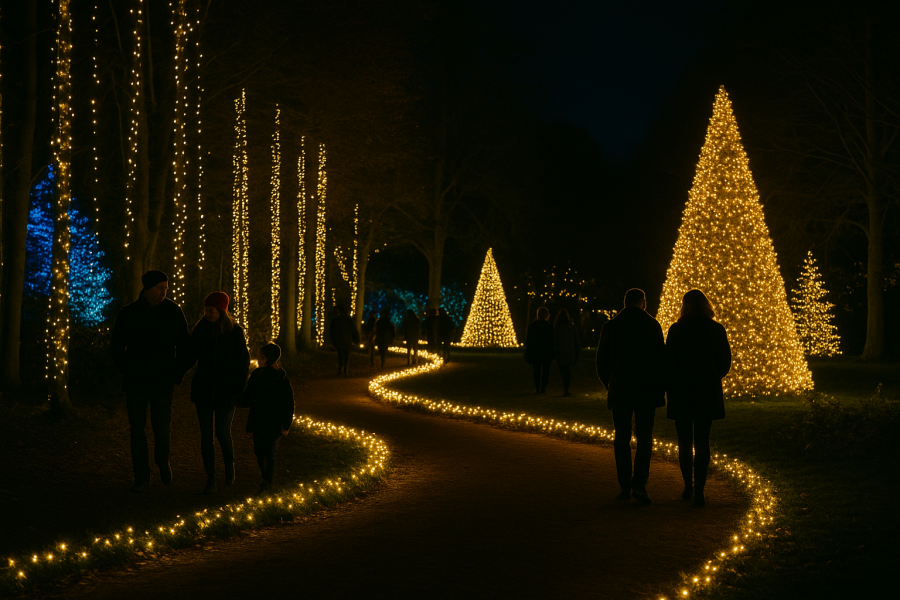As the festive season approaches, towns, parks, and venues across the UK come alive with the glow of Christmas lights — and for many, a light trail isn’t just an event, it’s a tradition. Families, friends, and couples venture out together for a shared evening of wonder. It’s a chance to catch up, reconnect, and make memories — wrapped up in scarves, sipping hot chocolate, and strolling through glowing landscapes.
A well-designed Christmas light trail taps into that seasonal magic. It isn’t about blasting music or overwhelming effects — it’s about creating a peaceful, heartwarming space where conversations flow, laughter echoes, and the lights take centre stage. Whether you’re planning a community trail or a large-scale attraction, these tips will help you create a beautiful, memorable experience that brings people together year after year.
Why People Return to Light Trails Year After Year
Beyond the visual spectacle, the real draw of a Christmas light trail is emotional. These events have become cherished annual outings — something people look forward to each winter. Here’s why:
- Tradition: For many UK families, visiting a light trail is part of their holiday ritual, just like decorating the tree or watching a pantomime.
- Connection: Trails provide a quiet, engaging environment for catching up with loved ones — especially important during a season when life gets busy.
- Atmosphere: The best trails create a warm, gentle ambiance with subtle soundscapes, not intrusive soundtracks, allowing visitors to chat, laugh, and share the moment.
- Nostalgia & Joy: Walking through sparkling trees and glowing paths evokes childhood wonder and offers a temporary escape from the hustle of daily life.
Designing with these feelings in mind helps ensure your trail is more than just impressive — it becomes meaningful.
1. Start Planning Early
Christmas light trails require months of preparation — from permissions and logistics to creative planning and sourcing the right lighting technology. We recommend starting your design process at least 6–9 months in advance, especially if you’re planning for a public space with health & safety requirements.
2. Define the Visitor Journey
Think of your light trail as a storybook guests walk through. Ask yourself:
- Where does the journey start and end?
- Are there rest points, refreshment stalls, or interactive elements?
- How will visitors flow through the space without bunching up?
Use subtle lighting cues and pathway lighting to guide guests while keeping the magic intact.
3. Create a Thematic Story or Mood
Light trails that tell a story or evoke a strong theme often generate more buzz. Popular UK themes include:
- Enchanted Woodland
- Winter Wonderland
- Fairy Tales and Fantasy
- Local Heritage and History
Themes help unify the design and allow for storytelling through light, sound, and installations.
4. Mix Static and Dynamic Lighting
A good trail balances different types of lighting effects:
- Static displays: Light sculptures, glowing trees, and architectural uplighting.
- Dynamic elements: Moving lights, synchronized color shifts, or sound-activated installations.
At Lumatech, we often combine projection mapping, LED tunnels, and smart lighting sequences to bring scenes to life and engage visitors in new ways.
5. Add Layers of Sound and Interactivity
Subtle soundscapes — like soft snowfall, woodland whispers, or instrumental music — add emotional depth without overwhelming the environment. Avoid loud or fast-paced tracks that make conversation difficult.
You can also add interactive installations that respond to movement or sound — from light-responsive stepping stones to “magic” buttons that animate a nearby display. These elements elevate the experience and make it more shareable on social media.
6. Consider Eco-Friendly Solutions
UK audiences are increasingly eco-conscious. Using low-power LED systems, solar-powered lights, and recyclable display materials can boost your trail’s sustainability and your public image. Mentioning your eco-friendly efforts in marketing materials also resonates with today’s audiences.
7. Make It Accessible and Safe
Good lighting design is both beautiful and functional. Make sure:
- Pathways are well-lit and free of trip hazards.
- The route is suitable for wheelchairs, prams, and mobility aids.
- All exits and emergency zones are clearly marked.
If you’re hosting in woodland or rural areas, use anti-slip surfaces and have trained staff on hand for guidance and support.
Final Thoughts
Designing a magical Christmas light trail takes creativity, planning, and technical know-how. But when done right, it becomes a festive landmark — the kind people talk about for years. Whether you want to enchant visitors with fairy-tale landscapes or dazzle them with immersive tech, Lumatech can help bring your vision to life — from concept to switch-on.
👉 Planning your 2025 light trail? Contact us to discuss your event.
